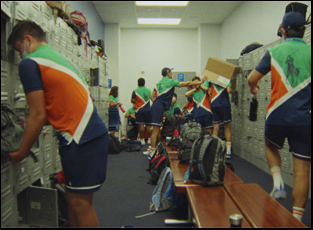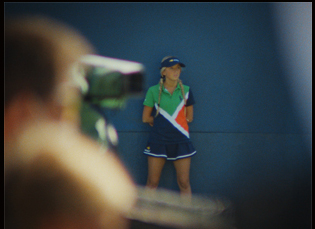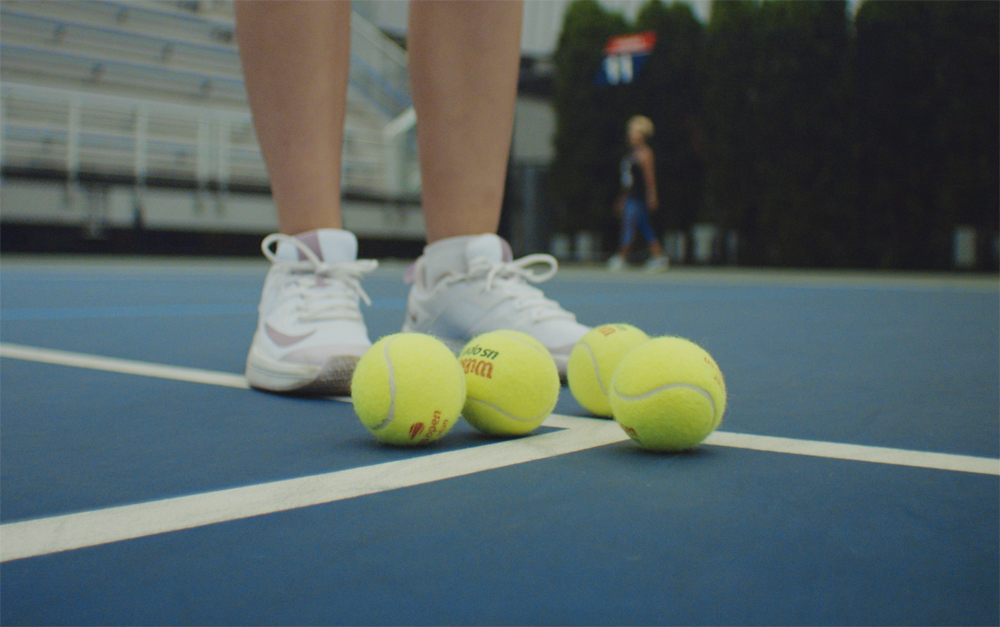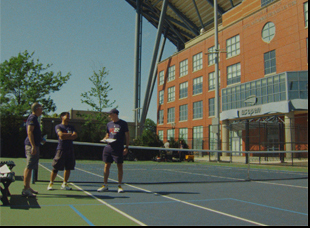There might be intense pressure on anyone who plays at Arthur Ashe Stadium in New York during the U.S. Open where 23,000 spectators pack in to watch the world’s best at tennis trade volleys, but all those eyes don’t leave the court in between sets when a much less heralded collection of athletes must scoop up the failed serves and missed backhands so rapidly to as if to be invisible. They get their closeup in the fittingly spry short doc “Ball People” where director Scott Lazer follows the tryouts for the crew working the 2022 event in which a group of 500 applicants is whittled down to a mere handful who will ultimately face the same scrutiny as the top-billed names to keep the game going.
As Katherine Soto, one of the aspirants says, “That’s the best seat in the house – you’re right on court with them” of why so many come out to be put through the paces and as Lazer finds, it isn’t just wide-eyed teenagers and twentysomethings who look forward to being part of the sport, meeting many who are older and have kept their youthful enthusiasm by continuing to apply when the tryout experience alone is exhilarating. It’s a fascinating and unexplored area of something we’ve probably all passively seen before, fast becoming a specialty of Lazer, who is premiering the film at SXSW a year after bringing his narrative short “West By God,” about a first date in Appalachia, to the festival following a celebrated premiere in Berlin, and when the director was in Austin, he spoke about how his curiosity led him to make a film out of the tryouts, covering such a large swath of applicants with limited time and the through line that connects his forays in fiction and documentary.
I was watching Wimbledon in 2019 and the ball crew executed this very synchronized movement on the court which caught my attention, and I took note of it in a way that I hadn’t before. I’m a pretty avid tennis player and have watched tennis my whole life, but for whatever reason, this choreographed movement [made me] curious about how one becomes a ball person. I looked up my closest Grand Slam, which is the U.S. Open and found out there was a trial process that I thought was so great. Unfortunately, because Wimbledon is in the summer, the trials had already passed for that year, so it wasn’t really realistic for me to make a film about it and I said, “Okay, I’ll just do that next year,” and of course that was first year of the pandemic. 2021 was more or less the same in terms of how large-scale sporting events were going, so in 2022, I thought I would attempt to pursue this project in earnest.
Is it a difficult event to cover? You hear how many applicants they get.
Yeah, it was a bit chaotic, to be honest. They come and go very quickly during the tryouts, and [the individual tryout] only lasts about 25 or 30 minutes, so we had identified our evaluators that we wanted to cover as characters, but the applicants were just an avalanche of people coming and going, so we would observe what was going on, see if we found any interesting looking people [who might’ve been] extra enthusiastic about the process and we probably interviewed, about a third or maybe a little less of the total characters [we have in the film]. A lot of them didn’t make it into the film, but we gravitated towards the people that felt like they would be interesting and kept their information and had them submit their own videos once they, found out if they made the team or not. Then we filmed a few of them during the the tournament last summer.
One of the interesting parts of this is the age range of the applicants. Was that something that immediately grabbed you?
Yeah, what is unique about the U.S. Open ball crew is that there’s no upper age limit and the French Open, Wimbledon, Australia, I think it’s like somewhere in the 14 to 18 range, but the U.S. Open is [open to] anyone 14 and above, so that encourages people of all ages to apply and it was interesting, at least for me, because in a way I’m projecting my own mortality onto some of our characters and I think what was driving them was that they recognized that their bodies can only do. Even though this isn’t the most strenuous thing, it is physical and your body can only operate at that level of athleticism for so long. With Andrew [Norman] and even Mung Mung [Peng], listening to their stories and hearing them describe how this was almost an existential pursuit for them, I thought that was pretty inspiring. Andrew turned 60 [either] the day we interviewed him or maybe during the Open and watching him run and almost fall and collect himself was pretty impressive to watch. That was definitely an angle the story that was extremely important.
Was there any directions this took that you might not have been expecting?
I didn’t know exactly how the evaluators would render on screen, and I thought that it was going to be pretty narrowly focused on the applicants. But I met Harry [Villareal] and even Tiahnne [Noble], the director of the ball crew — just that title alone is fascinating to me — and then of course, Rob [Sokoloff] and Sal [Chan, the tough-talking New York evaluators], who [all] provide a level of athleticism and professionalism that they expect from the applicants, but also an amazing well of humor that I got to watch unfold in real time on a long lens, listening to their mics. They were so funny and so endearing and they made the film, in my opinion.

The first day we showed up, we didn’t really know how it was going to go. It was a long weekend of tryouts and I wasn’t exactly sure how it was going to go. We had identified Harry as a character and that was it, so it was very exploratory at first. The first day we spent doing pretty much all handheld camera work, where we were very much following the action, and on day two and three, once we got an understanding of the rhythm of how it went, we could compose our shots a little better and frame how we wanted the scene to look and let the camera record for extended periods so that we can capture all these great moments. It was a bit of a combination of chasing the action and also having the patience to just let the camera roll and [after] those three days of filming, [we went back to] the actual tournament for one da, and by then we had an edit of the first five or six minutes of the film, so we could add what we wanted to and it was very fun to just find our feet in there.
When you move between narrative and nonfiction work, do they end up informing each other?
Yeah, part of what I’m drawn to in documentaries is the exploratory aspect of it. I feel like an adventurer. When I’m finding characters and exploring worlds that’s very exciting for me just as an individual and I get to use the camera as a means to investigate these communities and places that I’ve otherwise probably wouldn’t have access to. What I love about scripted or filmmaking is the ability to really think about what it is you know you’re trying to put on the screen and have total control over what that is, so I do find several moments in “Ball People” [where I] felt a similar muscle being exercised [as in my narrative “West By God”] where I was describing to you [how we were] letting the action come into the frame rather than chasing it down.
On the flip side, from a production standpoint, I’ve come to really love the nimbleness of a smaller documentary-type crew, which was the case for “West by God.” It was not a big crew — probably 12 or 13 of us total, including the actors and it was a similar production apparatus. It was a lot of the same crew members and having that shorthand and that familiarity with one another was super helpful. Even though they’re different projects I definitely feel some through lines across them both.
It’s got a really fun, mischievous score. Was that something you had in mind from the start of this?
It was. I’d worked with Jeff Melanson, the composer, on my film “Visitors” from a few years ago and he plays what I thought [initially] was a bassoon, but it turns out is a clarinet that he pitches down. So I [said to] our music supervisor Rachel Helman. it’d be good to find some bassoon references that we could maybe use in the edit as a reference track and then give it to Jeff as an idea of what we’re thinking. She found this composition, which plays a couple times in the film, but it was so good that I ended up saying, [let’s] license this piece of music, but we still had a lot more of the film that needed music and I sent Jeff a cut at some point and we used a couple of his compositions, two of [which] were in films that didn’t ever get released. Then he wrote two original compositions, one called “Ball People” and one called “Deuce” that we used in the film as well and there was a license track from a Swedish chamber orchestra to Jeff’s existing songs and original compositions, so even though they come from all different places in different times, there’s a really nice cohesion. That was a very fun part of the process. Sound in general is very interesting to me, but music is top of pile in terms of how you’re building your audio bed.

Our editor Nico Frank is so great at making connections with the material that we give her and that particular scene, there’s music, dialogue, and everybody wondering if they’re going to make crew or not, so she edited it in this really beautiful radio format, and then picture edited the images of people waiting to come onto the court to try out. It was so strong that when I first saw that, it has been there since the first edit. And then the dramatic question of this is, simply put, are they going to make the team? And we were trying to figure out the best way to go about capturing that and everyone’s more or less based in New York, so I thought maybe we could spend a day just driving around and film them, but it wasn’t realistic to do that for both for both practical and financial reasons. Talia Cohen, one of our producers, suggested [because] we had all their contact info, let’s tell them once they get the e-mail [from the U..S Open] to record themselves on their phone or laptops, reading the results. It’s one of my favorite moments of the film and it has all the things that the rest of the film has, which is some emotion, some humor, and an earnestness that actually was underscored by the laptop webcam look of it.
What’s it like getting this out into the world?
Our first screening was yesterday and we got a lot of laughs and it was very gratifying to experience that in the moments that I was hoping they would happen, but then also a lot of moments that I wasn’t expecting and I’m excited to play it again on Thursday to a new audience. The plan with the film is to release it right before the U.S. Open this year as a preview, so I feel really great about how this has come about and with all these short films that I’ve been doing, they feel like they’re getting closer and closer to the type of stories that I’m interested in telling, and it’s just very gratifying to see an idea I had on my couch almost four years ago realized on screen.
“Ball People” will screen at SXSW as part of the Documentary Shorts Program 1 on March 16th at 3:30 pm at the Alamo Lamar D.





